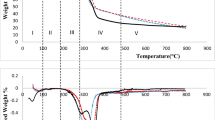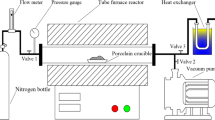Abstract
The contents of ash and chlorine, and the heating value are important factors for the utilization of biomass. In this work, the washing of corn straw with water for de-ash, de-chlorination, and increase of the heating value was investigated. Before washing, the corn straw was ground to powders and fractionated into different particle sizes. The particles less than 38 μm were found in higher content of chlorine, and thus were removed and only the powders in the range of 38–250 μm were examined. Three independent variables of the liquid/solid ratio (L/S), the washing time (t), and the washing temperature (T) were investigated in the washing experiments. A mathematical model was constructed by response surface methodology (RSM). The results showed that the parameter of L/S was most significant, followed by the order of t, the interaction between L/S and t, and T. The reliability of the model was verified by analysis of variance and by comparison with laboratory results. According to the model prediction, the optimal conditions of L/S, washing time, and temperature were respectively determined as 39.98 mL/g, 11.55 min, and 30 °C. The details of the washing influence were further investigated, by characterizations of the eluate and the solid samples before and after washing.
Graphical abstract






Similar content being viewed by others
Data availability
Data available within the article.
References
Akhtar A, Krepl V, Ivanova T (2018) A combined overview of combustion, pyrolysis, and gasification of biomass. Energy Fuels 32:7294–7318
Kan T, Strezov V, Evans TJ (2016) Lignocellulosic biomass pyrolysis: a review of product properties and effects of pyrolysis parameters. Renew Sustain Energy Rev 57:1126–1140
Keipi T, Tolvanen H, Kokko L, Raiko R (2014) The effect of torrefaction on the chlorine content and heating value of eight woody biomass samples. Biomass Bioenergy 66:232–239
Robin A, Sack M, Israel A, Frey W, Müller G, Golberg A (2018) Deashing macroalgae biomass by pulsed electric field treatment. Bioresour Technol 255:131–139
Lavric ED, Konnov AA, De Ruyck J (2004) Dioxin levels in wood combustion—a review. Biomass Bioenergy 26:115–145
Keiser JR, Brady MP, Thomson JK, Connatser RM, Leonard DN (2014) Bio-oil Properties and Effects on Containment Materials. CORROSION 2014:4423
Jeong Y, Lee Y-E, Kim I-T (2020) Characterization of sewage sludge and food waste-based biochar for co-firing in a coal-fired power plant: a case study in Korea. Sustainability 12:9411
Rahim MU, Gao X, Garcia-Perez M, Li Y, Wu H (2013) Release of chlorine during mallee bark pyrolysis. Energy Fuels 27:310–317
Hess D, Wendt LM, Wahlen BD, Aston JE, Hu H, Quinn JC (2019) Techno-economic analysis of ash removal in biomass harvested from algal turf scrubbers. Biomass Bioenergy 123:149–158
Peng B, Li X, Luo J, Yu X (2019) Fate of chlorine in rice straw under different pyrolysis temperatures. Energy Fuels 33:9272–9279
Nhuchhen DR, Salam PA (2012) Estimation of higher heating value of biomass from proximate analysis: a new approach. Fuel 99:55–63
Singhal A, Konttinen J, Joronen T (2021) Effect of different washing parameters on the fuel properties and elemental composition of wheat straw in water-washing pre-treatment. Part 1: effect of washing duration and biomass size. Fuel 292:120206
Singhal A, Konttinen J, Joronen T (2021) Effect of different washing parameters on the fuel properties and elemental composition of wheat straw in water-washing pre-treatment. Part 2: effect of washing temperature and solid-to-liquid ratio. Fuel 292:120209
Gudka B, Jones JM, Lea-Langton AR, Williams A, Saddawi A (2016) A review of the mitigation of deposition and emission problems during biomass combustion through washing pre-treatment. J Energy Inst 89:159–171
Zevenhoven M, Yrjas P, Skrifvars B-J, Hupa M (2012) Characterization of ash-forming matter in various solid fuels by selective leaching and its implications for fluidized-bed combustion. Energy Fuels 26:6366–6386
Ma Q, Han L, Huang G (2017) Evaluation of different water-washing treatments effects on wheat straw combustion properties. Bioresour Technol 245:1075–1083
Jenkins B, Bakker R, Wei J (1996) On the properties of washed straw. Biomass Bioenergy 10:177–200
Lei D, Tao Z, Che D (2013) Effect of water washing on fuel properties, pyrolysis and combustion characteristics, and ash fusibility of biomass. Fuel Process Technol 106:712–720
Vallejos ME, Zambon MD, Area MC, da Silva Curvelo AA (2012) Low liquid–solid ratio (LSR) hot water pretreatment of sugarcane bagasse. Green Chem 14:1982–1989
Stefanidis SD, Heracleous E, Patiaka DT, Kalogiannis KG, Michailof CM, Lappas AA (2015) Optimization of bio-oil yields by demineralization of low quality biomass. Biomass Bioenergy 83:105–115
Zheng Q, Zhou T, Wang Y, Cao X, Wu S, Zhao M, Wang H, Xu M, Zheng B, Zheng J (2018) Pretreatment of wheat straw leads to structural changes and improved enzymatic hydrolysis. Sci Rep 8:1–9
Jiang D, Fang Z, Chin S-x, Tian X-f, Su T-c (2016) Biohydrogen production from hydrolysates of selected tropical biomass wastes with Clostridium butyricum. Sci Rep 6:1–11
Podstawczyk D, Witek-Krowiak A, Dawiec A, Bhatnagar A (2015) Biosorption of copper (II) ions by flax meal: empirical modeling and process optimization by response surface methodology (RSM) and artificial neural network (ANN) simulation. Ecol Eng 83:364–379
Chen L, Wei Y, Shi M, Li Z, Zhang S-H (2020) Statistical optimization of a cellulase from Aspergillus glaucus CCHA for hydrolyzing corn and rice straw by RSM to enhance yield of reducing sugar. Biotech Lett 42:583–595
Sodeifian G, Sajadian SA, Ardestani NS (2016) Extraction of Dracocephalum kotschyi Boiss using supercritical carbon dioxide: experimental and optimization. J Supercrit Fluids 107:137–144
Thite VS, Nerurkar AS, Baxi NN (2020) Optimization of concurrent production of xylanolytic and pectinolytic enzymes by Bacillus safensis M35 and Bacillus altitudinis J208 using agro-industrial biomass through response surface methodology. Sci Rep 10:1–12
Khuri AI, Mukhopadhyay S (2010) Response surface methodology. Wiley Interdiscip Rev Comput Stat 2:128–149
Singhal A, Goossens M, Konttinen J, Joronen T (2021) Effect of basic washing parameters on the chemical composition of empty fruit bunches during washing pretreatment: a detailed experimental, pilot, and kinetic study. Bioresour Technol 340:125734
Vassilev SV, Baxter D, Andersen LK, Vassileva CG (2013) An overview of the composition and application of biomass ash. Part 1. Phase–mineral and chemical composition and classification. Fuel 105:40–76
Liu Y-j, Yan T-g, Yan A, Zhang W, Yang D (2021) Influence of water leaching on alkali-induced slagging properties of biomass straw. J Fuel Chem Technol 49:1839–1849
Xiao X, Chen B, Zhu L (2014) Transformation, morphology, and dissolution of silicon and carbon in rice straw-derived biochars under different pyrolytic temperatures. Environ Sci Technol 48:3411–3419
Funding
We acknowledge financial support by the National Key R&D Program of China (2019YFC1906700).
Author information
Authors and Affiliations
Corresponding author
Ethics declarations
Conflict of interest
The authors declare no competing interests.
Additional information
Publisher's note
Springer Nature remains neutral with regard to jurisdictional claims in published maps and institutional affiliations.
Statement of novelty
The fraction of particles less than 38 μm is found rich in ash and chlorine, and is suggested to be eliminated before washing, which is advantageous for reducing the consumption of water. A mathematical model is built with response surface methodology. Through the model analysis, the influence of liquid-to-solid ratio in the range of 10–40 mL/g is found most significant for the water-washing of the powders of corn straw (38–250 μm), while the influence of temperature (T) and the interactions between T and other variables are weak. The eluate is analyzed with ion chromatography (IC), and HPO42− is found much extracted from corn straw. The microscopic surface of the corn straw becomes more smooth after washing.
Rights and permissions
About this article
Cite this article
Zhang, W., Wang, Z., Yang, C. et al. Investigation on the water-washing of corn straw for de-ash, de-chlorination, and increase of heating value through response surface methodology. Biomass Conv. Bioref. 14, 2129–2140 (2024). https://doi.org/10.1007/s13399-022-02479-0
Received:
Revised:
Accepted:
Published:
Issue Date:
DOI: https://doi.org/10.1007/s13399-022-02479-0




